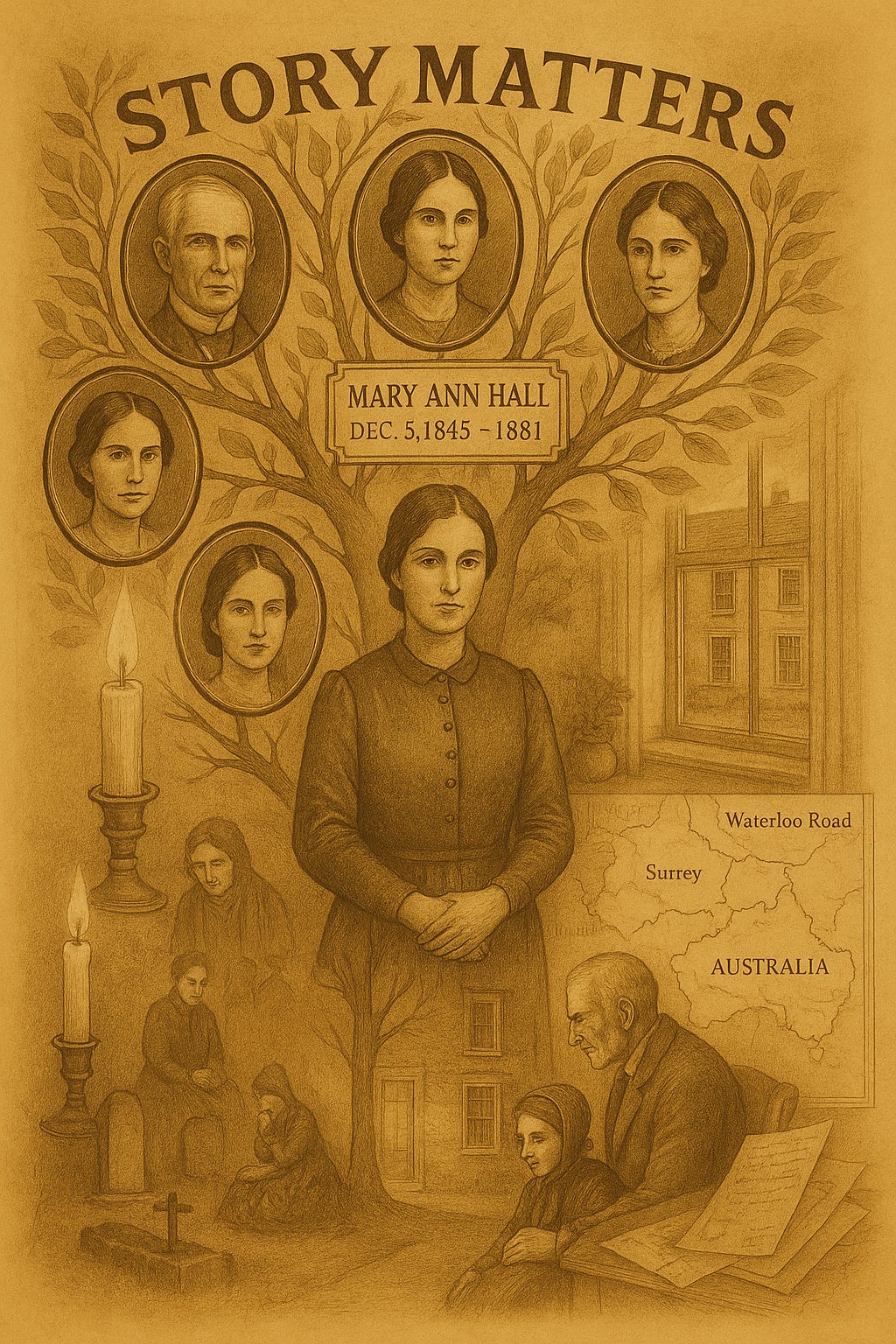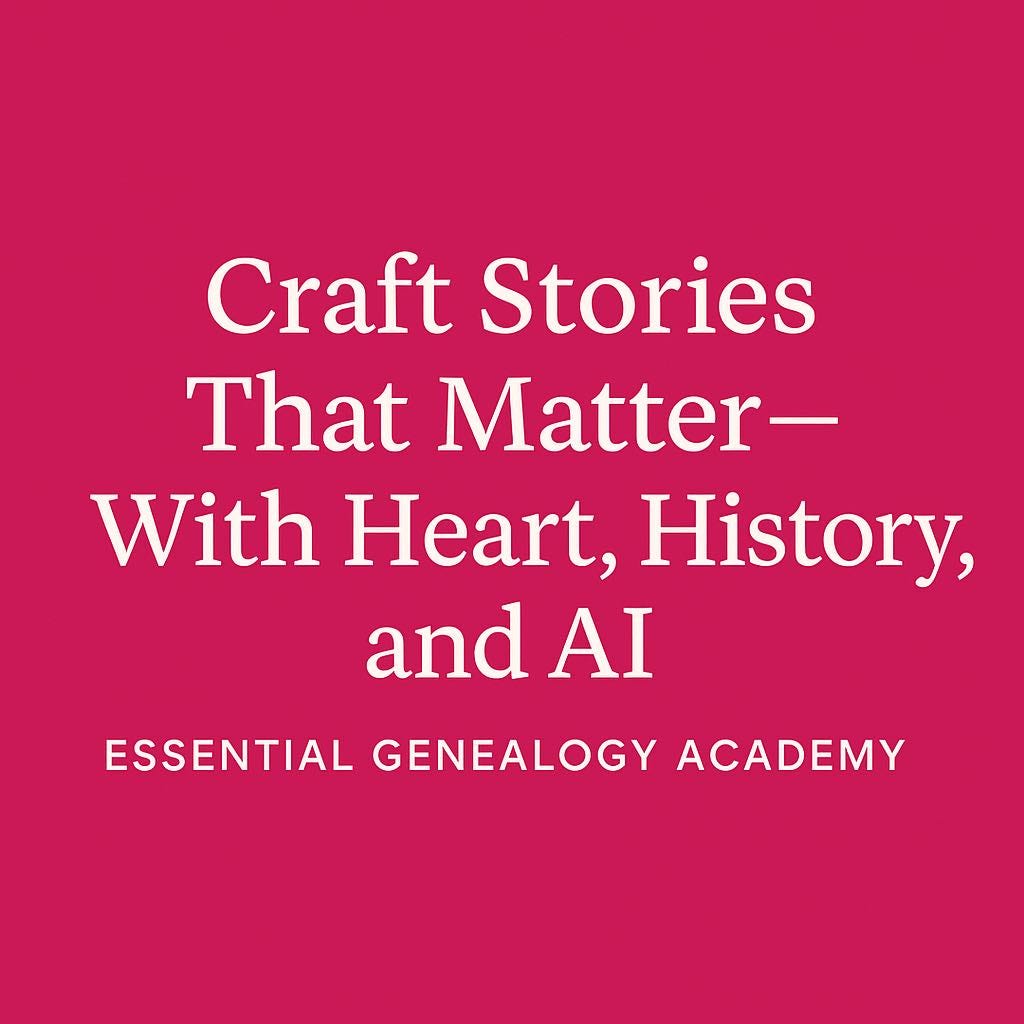“Your Story Matters” Series
In this series, I will share my story process with you and highlight key moments in my journey. In this first episode, I am featuring my great-grandmother, Mary Ann Hall.
"When I Felt Lost in My Research..." - Turning Facts into Family Stories
Ever felt overwhelmed by folders of facts but no story to tell? I used to collect names and dates without knowing what to do with them. That changed the day I asked, What if AI could help me write the stories my ancestors deserved? That moment became the seed of Essential Genealogy Academy.
Got decades of research… But no story to show for it?
You’re not alone.
You’ve got names, dates, and places—but they’re still locked in folders or family tree software.
What you want is to tell stories that honour your ancestors…
Without the overwhelm. Without the tech fear.
And definitely without losing your voice.
That’s where we come in. Join us in the Essential Genealogy Academy.
.
The Problem We All Face
• Information overload: My computer folders were bursting with census images and certificates
• Contextual confusion: I knew when people lived, but not how they lived
• Writer's block: I'd stare at my research and think, "Now what?"
• No clear direction: I wasn't sure if I was writing for my children, distant cousins, or myself.
• Limited time: Between research and life, when would I write these stories?
How AI is Changing My Approach
• Organizing scattered information: Helping me see patterns in seemingly random facts
• Filling historical gaps: Suggesting contextual elements I hadn't considered
• Generating fresh perspectives: Offering new angles when I'm stuck in one viewpoint
• Adapting to different readers: Helping craft stories appropriate for different family members
• Streamlining the process: Turning weeks of writing work into focused sessions
Practical Steps You Can Take Today
Choose just one ancestor: Don't try to tell everyone's story at once
List what you know. Create a simple timeline of their major life events
Note the gaps: What questions do you still have about their life?
Find the "story hook": What aspect of their life intrigues you most?
Set a small, achievable goal: Writing even a one-page narrative is a success
Start with a vivid scene: Begin with a moment that captures their essence
Case Study: Mary Ann Hall (1845-1881)
Mary Ann Hall
When Mary Ann Hall was born on 5 December 1845, her father, Henry, was 41, and her mother, Sarah, was 40. Mary Ann Hall was born in Walworth, London, during a time when the city was growing rapidly, and families like hers navigated crowded streets and changing fortunes. She was baptised just weeks later, on 14 January 1846, affirming her place within the local parish and family traditions.
By the age of six, Mary Ann was living in Southwark St. George, Surrey, recorded in the 1851 census as the daughter of Henry James Hall and Sarah Ann Jones. She grew up in a bustling London neighbourhood, likely contributing to household duties and later learning the skilled trade of tailoring—a common and respectable path for working-class women in Victorian England.
At the age of 15, she was a scholar living in her brother George Hall's residence at 16 Belvedere Place, in the parish of St. George the Martyr, Southwark.
She married Samuel John Allery on 2 December 1867 in England. She was then 22 years old. Their first child, Henry John, arrived just weeks later, born on 31 December 1867 at Arnery Place, Old Kent Road. Mary Ann married a man who shared her London roots and aspirations. Over the next 12 years, Mary Ann gave birth to six children:
Henry John (1867-1947)
Rosina Elizabeth (1870-1935)
Walter Frederick (1871-1915)
Jessie Amelia (1876-1944)
George Samuel (1878-1896)
Jenny Selina (1880-1881)
The growing family moved through various parts of London, including Bermondsey, St. Bride Fleet Street, and Holloway. Amidst the demands of motherhood, Mary Ann worked as a tailoress, as recorded in the 1881 census—sewing likely provided both income and a creative outlet within the home.
But Mary Ann's final years were marked by sorrow. She lost her sister Ann Louisa Hall in 1876, her sister Charlotte Hall in 1879, and her infant daughter Jenny Selina in September 1881. Just weeks later, both of her parents passed away—Henry James Hall in October and Sarah Ann Jones also that same month, though at a distance, in Cheshire.
Mary Ann herself died shortly thereafter, on 19 December 1881, on Waterloo Road, Surrey, at the young age of 36. In a single year, the Hall family suffered a cascade of losses, with Mary Ann's death closing a chapter heavy with grief and resilience.
What AI Helped Me Discover About Mary Ann's Story
Working with AI helped me to:
• Visualize Victorian London: See beyond census entries to imagine Mary Ann's daily reality
• Understand tailoring work: Learn how this skilled trade shaped her identity and family economy
• Explore grief patterns: Consider how the multiple losses in 1881 affected the family structure
• Raise new questions: Wonder about the connection between her infant daughter's death and her passing
• Add sensory details: Picture the Waterloo Road setting where her life ended
What's Your Story Challenge?
• What ancestor are you struggling to bring to life on the page?
• Which aspect of storytelling do you find most difficult—setting, character, or historical context?
• Have you tried using technology to overcome writer's block in your family history?
• What's one fascinating detail about your ancestor that deserves to become a full narrative?
Next week, I'll share how AI tools help you write faster, with more confidence.
Helping you stay in charge.
Tell me—what part of your research do you struggle to shape into the story?
CTA: Tell me—what part of your research do you struggle to shape into the story?







My mother wrote facts, a timeline but there is a hint of some fun stories in there. I’d like to share those stories with my grandchildren. First person or third person?